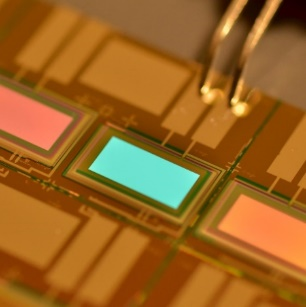
Towards the creation of more high-performance OLEDs
A team from the Bioorganic Chemistry and Marking Department (SCBM - Université Paris-Saclay, CEA) has carried out the first study that effectively correlates the structure and properties of light-emitting molecules for applications in organic electroluminescent diodes (OLED).
The OLED market is booming. Ever since the first prototypes were created in the 80s, a number of giants in the display industry have invested in research and development in the field. In parallel, numerous research groups around the world have expanded their knowledge of the various molecules that make up OLEDs and their respective properties.
In order to emit light in an optimal manner in an OLED, these molecules must have the properties of delayed fluorescence and emitting circularly polarised light. The former property provides a theoretically total conversion of electrical energy to light, whereas the latter allows the light emitted to pass through the filters fitted to the OLED. The filters prevent external light - sunlight, street lighting - reflecting off the OLED’s surface, but unless the system emits circularly polarised light, 50% of the intensity of the light produced by the diode will be lost.
These entirely organic molecules - carbon-based and metal-free - were described for the first time in 2015. Until today, new examples were very rare and large-scale applications were unthinkable.
A consortium of researchers from CEA Saclay, ENS Paris-Saclay, Rennes University, and LETI (CEA-Grenoble) carried out the first systematicand in-depth study of molecules with the properties of delayed luminescence and emitting circularly polarised light. The researchers synthesised a series of ten new molecules of a similar design but with some slight structural differences.
With the help of theoretical calculations that precisely modelled the structures of the molecules, and using the properties they measured, they established a relationship between the structure and the properties that highlighted the structural parameters needed to obtain the best properties.
Furthermore, some of these molecules have been used to perfect organic electroluminescent diodes that emit circularly polarised light and are compatible with the manufacture of portable high-definition screens.
Thanks to the guidelines laid down by this study, it will soon be easier to access new high-performance molecules for OLEDs effectively and to develop applications that require these properties. New molecules based on this work are expected to be unveiled in the future and will allow display systems that consume less energy to be designed.
Référence :
Lucas Frédéric et al., Maximizing Chiral Perturbation on Thermally Activated Delayed Fluorescence Emitters and Elaboration of the First Top‐Emission Circularly Polarized OLED. Advanced Functional Materials, August 2020.


